The immersive Côte Bleue Marine Park
Since 1983, a Marine Park has spread over 15,000 ha in front of the 28 kilometers of the Côte Bleue stretching from Anse des Laurons in the west to the tip of Corbières in the east.
The Côte Bleue Marine Park manages all the artificial reefs submerged in front of the coast as well as two fully protected marine reserves, one in Carry-le-Rouet (85 ha) and the other in Cap-Couronne (210 ha).
The measures and arrangements in favor of resource management are the result of a permanent dialogue between the administration, communities, fishermen and professional fishing organizations.
The Côte Bleue Marine Park manages all the artificial reefs submerged in front of the coast as well as two fully protected marine reserves, one in Carry-le-Rouet (85 ha) and the other in Cap-Couronne (210 ha).
The measures and arrangements in favor of resource management are the result of a permanent dialogue between the administration, communities, fishermen and professional fishing organizations.
The Côte Bleue Marine Park has been registered since November 24, 2018 on the green list of protected areas of the International Union for the Conservation of Nature. This distinction is awarded to protected areas that meet several standards regarding management effectiveness and local governance.
Immersion and artificial narratives
Production reefs have a role of attraction, shelter and support for flora and fauna. More than 2,500 m3 have been submerged on bottoms devoid of natural habitats, and are monitored regularly.
Protective reefs constitute obstacles to trawling (net towed on the bottom) in the coastal strip where this technique is prohibited, unlike set nets. Thus, more than 300 of these reefs make it possible to protect the most fragile funds such as Posidonia meadows and coralligenous rocks.
The studies carried out on the Blue Coast have largely contributed to the identification of a set of phenomena commonly known as the "reserve effect".
→ Increase in the number of species
→ Increase in the number and size of fish
→ Regularity of the presence of sought-after species such as: corb, sea bream, denti, wolf, grouper ...
→ Recolonization of shallow sites and export to peripheral areas
Protective reefs constitute obstacles to trawling (net towed on the bottom) in the coastal strip where this technique is prohibited, unlike set nets. Thus, more than 300 of these reefs make it possible to protect the most fragile funds such as Posidonia meadows and coralligenous rocks.
The studies carried out on the Blue Coast have largely contributed to the identification of a set of phenomena commonly known as the "reserve effect".
→ Increase in the number of species
→ Increase in the number and size of fish
→ Regularity of the presence of sought-after species such as: corb, sea bream, denti, wolf, grouper ...
→ Recolonization of shallow sites and export to peripheral areas
Four kinds of habitats make up the seabed of the Côte Bleue.
HERBIER DE POSIDONIES is the most frequent landscape in the Mediterranean. The surface of the herbarium represents approximately 1050 ha on the Côte Bleue. The large green stems of Posidonia are home to many species such as the large mother-of-pearl. Posidonia is an important part of Mediterranean underwater life, which is why it is protected.
CORALLIGENE, in its mineral aspect, is made up of a set of calcified algae forming over the years a succession of strata. Many animals live there, both indoors and outdoors, such as the gorgon.
SANDY ZONES, which despite appearances are also home to a multitude of species, even if it is not always easy to see them because of their color similar to that of the bottom or because they live buried in the sand or leave only part of their body protruding. But if you look carefully, you may meet a sole, a goby or a brittle stars ...
THE ROCKY ZONES are very diversified (drop offs, slabs, caves) and are the support of an intense fixed life, and the privileged place of life of many animals.




